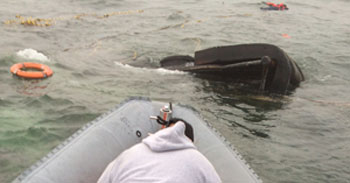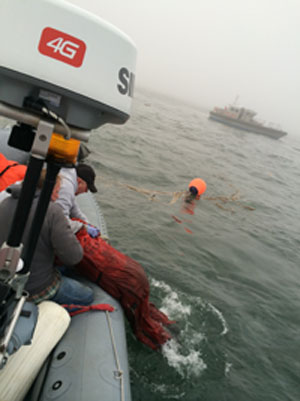With heavy fog, six-foot seas on the Atlantic Ocean off western Long Island and night approaching, the mayday call on Jan. 15 did not come at a good time.
Bjoern Kils, captain of the New York Media Boat, a 24-foot RHIB photography and sightseeing vessel, had just left the dock and was heading out of East Rockaway Inlet when the radio came alive with the distress call from a tugboat.
“I heard the VHF call: ‘Mayday. This is the Sea Lion. We’re sinking with men in the water. The water is in the wheelhouse. This is our last transmission. We’re going down.’”
A nearby Sandy Hook Pilots boat heard it too, and the crews on both vessels jumped into action.
 |
“I heard it very clearly on the VHF,” Kils said, so he figured he must be close. But he also thought the tug might be hard to find because “the conditions were very unfavorable with less than 200 feet visibility.”
The U.S. Coast Guard had provided coordinates that proved to be hundreds of miles off. So Kils turned on his AIS system and Sea Lion popped up as the closest target, about two miles to the south. “I figured that had to be it because I heard the mayday so clearly,” he said. “We dropped what we were doing and put the throttle down and ran down there at about 35 knots, trying to get there really quick.”
The pilot station boat New York was about six miles away when the mayday call came. “We had them on the AIS and on the radar, so we sent the (launch) America up there,” said Jack McCarthy, an apprentice pilot running New York that day. While the station boat headed for the scene, Capt. Rob Dobrowolski and crewmembers Mike Gove and Tom Sullivan climbed aboard the faster 53-foot America and surged ahead at 25 knots through zero visibility, homing in on a diminishing AIS signal as Gove prepared rescue equipment.
The Coast Guard is still investigating why the 65-foot steel-hull tug built in 1980 began to flood and capsized three miles south of Atlantic Beach. The tug had left Upper New York Bay en route to a towing job at Shinnecock Inlet on eastern Long Island when the Coast Guard got the first radio call at 1500. It sank at 1611 with four on board.
“The visibility was about a tenth of a mile,” Dobrowolski said. “We found them in dense fog. Three of them were on the side of the quickly sinking tugboat. The water was very cold: in the 30s. We wanted to get those guys as quickly as possible. At the same time, there was a lot of debris floating around the tug, including mooring lines. We tried to get as close as possible.”
Wayne Karnas, Mike Waldron and Chad Bergeron were coaxed into the water to facilitate rescue while Bryant Klein, badly injured, clung to the bow.
When the launch was about 20 yards from Sea Lion, Gove threw a life ring to the men in the water, who were wearing Mustang worksuits but not survival suits. “Two of them grabbed it and we pulled them to our pilot boat,” Dobrowolski said. They were brought to the stern where the rescue basket was located. “But things were happening so quick we had no time to raise the basket so we pretty much grabbed the guys and pulled them out of the water.”
Further action was stymied because mooring lines from Sea Lion had fouled the launch’s props.
Meanwhile, Kils said he arrived from the north as America was coming in from the south.
“We saw this boat in the water and we can make out a person laying across the bow,” he said. “There was only about two feet left of the boat sticking out of the water.”
Kils watched the other tug crew being rescued by America. “The last guy was complaining of chest pains and clutching his chest,” he said. “So we circled around. I maneuvered closer from the upwind side and nosed my boat against the hull of the tug. He attempted to leap toward us just as the last pockets of air escaped from the tug, erupting like a whale’s blowhole as she sank to the bottom in a boil. We were able to quickly pull him out of the cold water.”
“NYPD tried to launch a helicopter, but couldn’t because of the fog,” Kils said. “So I figured I should bring them over to the pilot ship because at least they had heat and probably some medical equipment on board.”
“He was complaining about serious chest pains and I was afraid he was having a heart attack,” Dobrowolski said of Klein. “It turned out to be cracked ribs. Eventually they were transferred to the New York” when the 185-foot vessel arrived to help and tow America. They were treated for hypothermia and the crewman with the difficulty breathing was given oxygen. The Coast Guard picked up the four crewmen from New York and brought them to Staten Island for treatment.
Kils said Klein called him two days after the rescue. “He told me that he had actually placed a call to his wife and left a voice message saying goodbye to her. He thought this was it for him. And he said, ‘out of the fog appears your boat.’ It was pretty cool.”
This was Kils’ first rescue at sea. “I was a lifeguard for many years and I would get the occasional person in the pool,” he said, “but nothing like this. It was spooky out there.”
In a January letter to Capt. Richard Schoenlank, president of the New Jersey Sandy Hook Pilots, George Wittich, president of Wittich Bros. Marine of Brielle, N.J., said he and his brother William, owners of Sea Lion, wanted to thank the 14 on board New York and America. “Their quick and professional response was the reason why these men are alive today,” Wittich wrote.
He added that he was “happy to report that the entire crew of the Sea Lion is in good health. Of the crewmembers that were admitted to the hospital on the evening of the casualty, all were released that same evening without suffering any injury. The prompt action of your crews ensured this outcome. Our crew was extremely grateful, citing that when receiving initial first aid, some of your men literally took the shirts off their backs to help facilitate a controlled return to normal body temperature.”
Wittich said, “the actions of your crew exemplify the highest levels of professional seamanship. While no one ever wants to lose a vessel, we were truly blessed that when our tug did go down, it was within VHF range of the Sandy Hook Pilots — and thankfully, your professional mariners were attentively standing watch and immediately reacted without hesitation.”
Schoenlank said, “anyone working on the water would do the same if they had the chance, knowing someday the situation might be reversed and that it could be you praying for a rescue boat to come blasting out of the fog as the vessel beneath you sinks into frigid water.”

